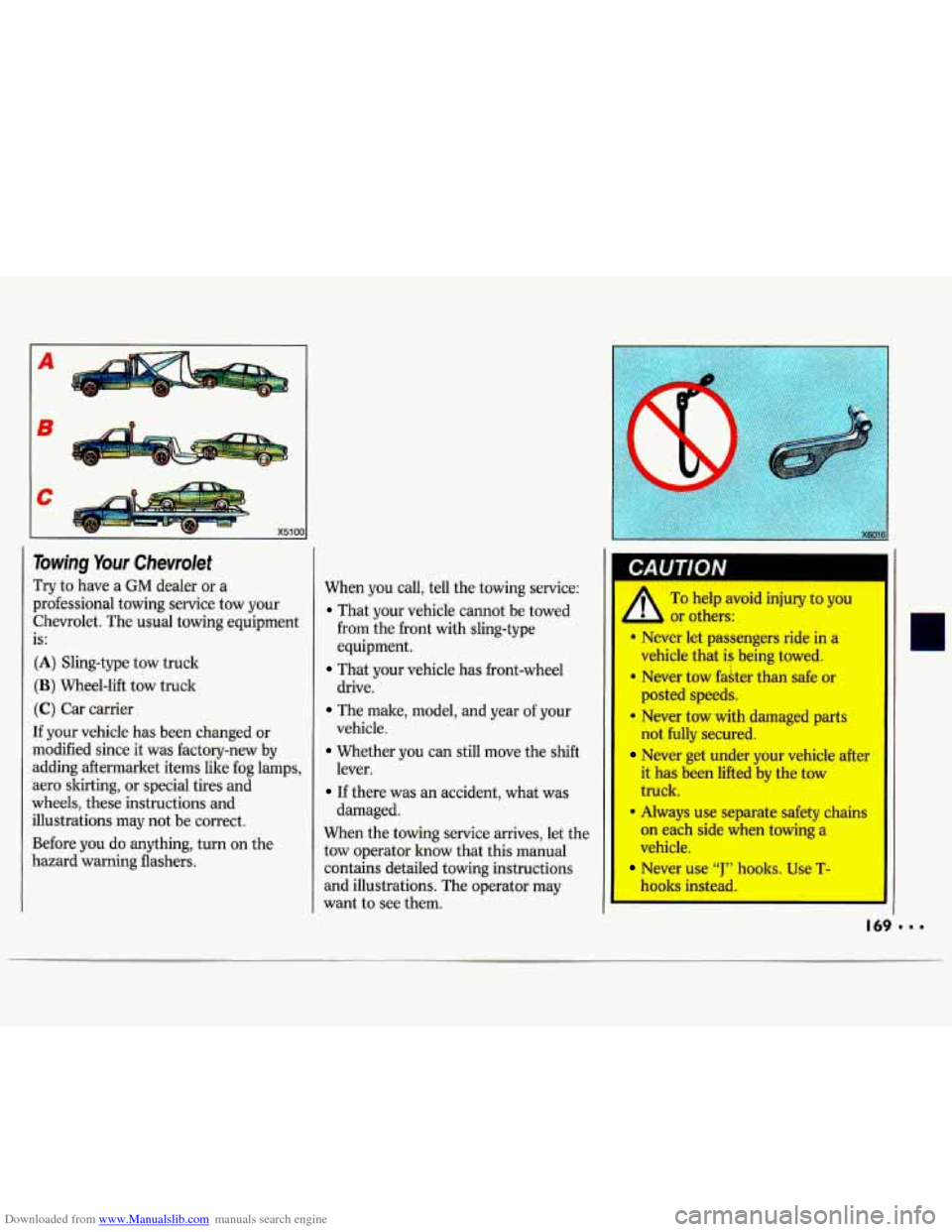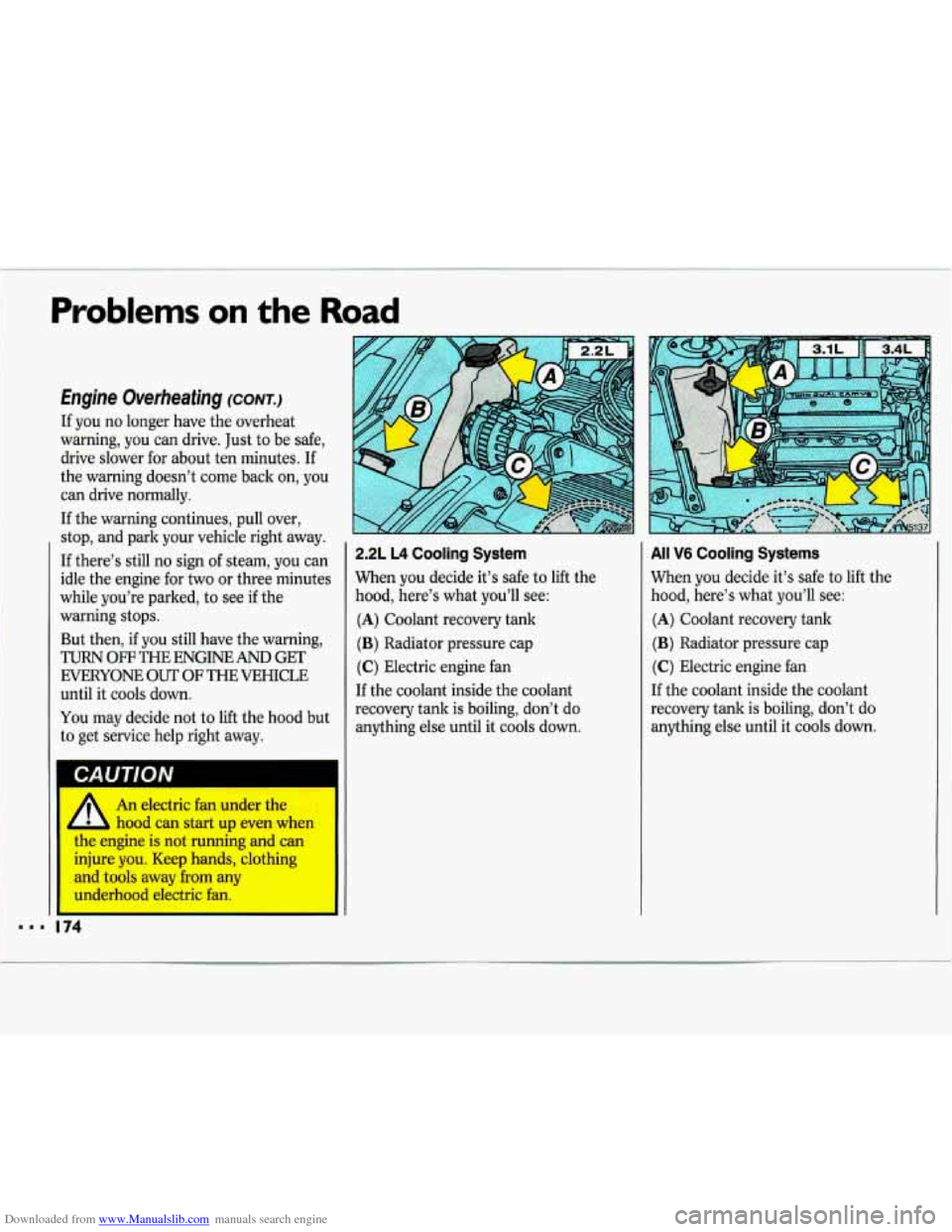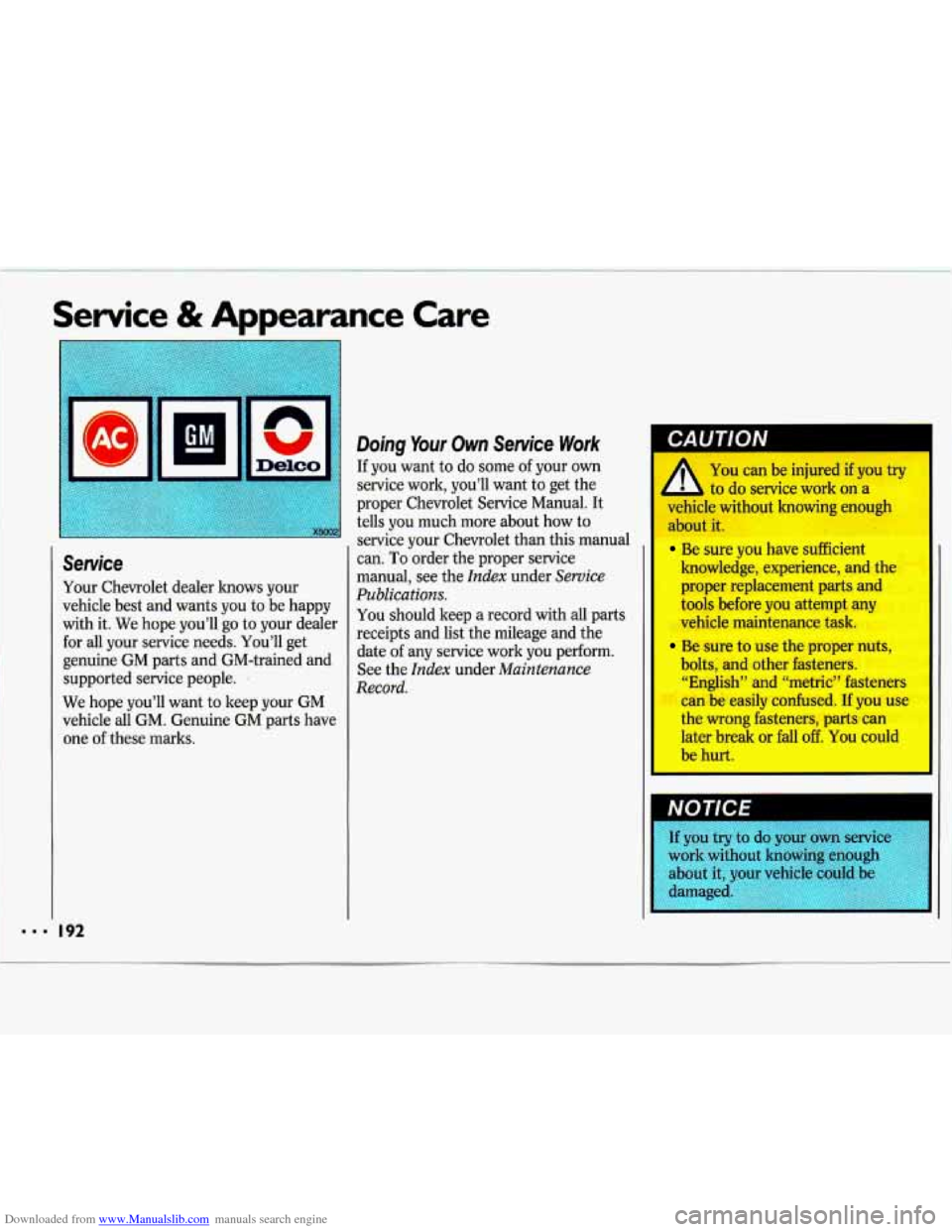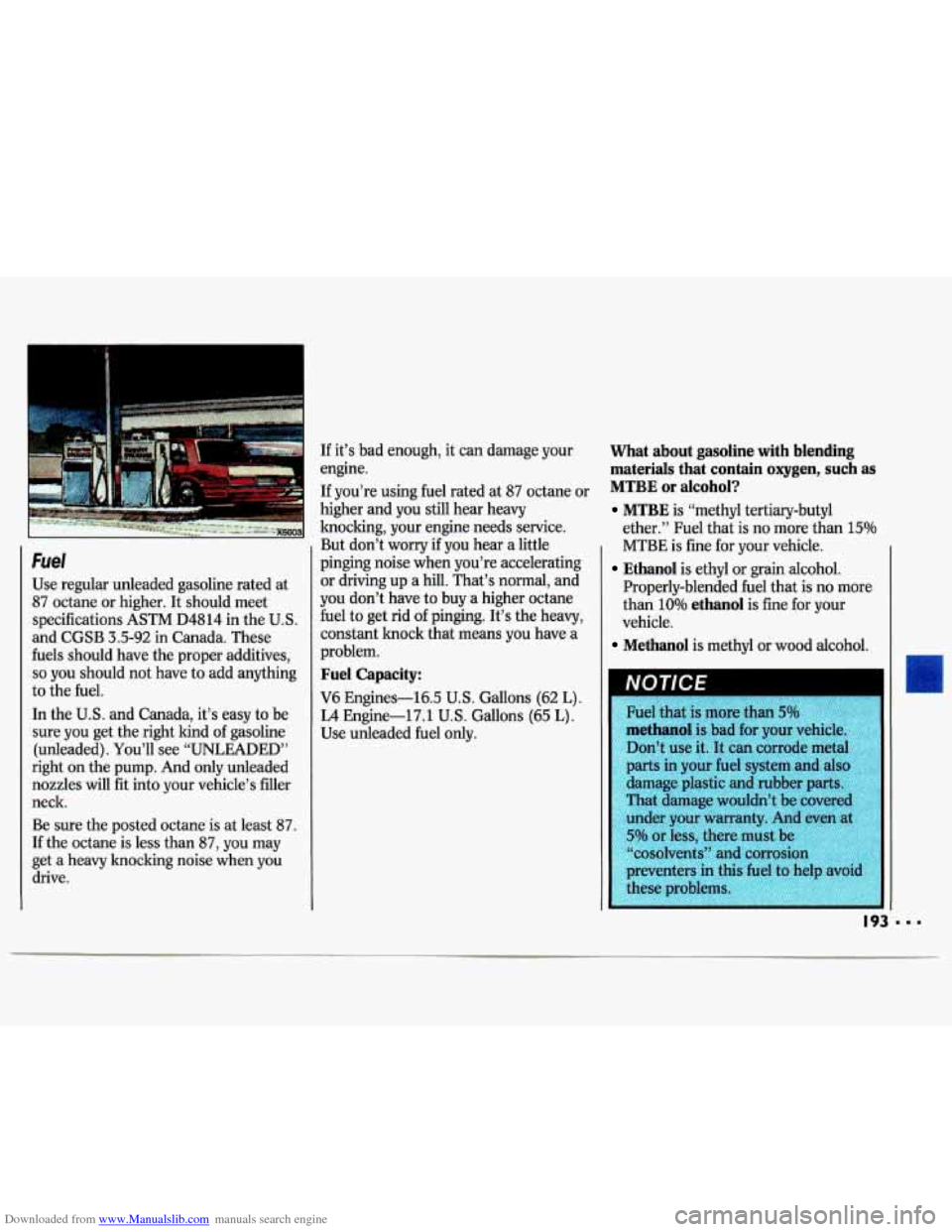1993 CHEVROLET LUMINA service
[x] Cancel search: servicePage 163 of 324

Downloaded from www.Manualslib.com manuals search engine Parking on Hills
You really should not park your vehicle,
with a trailer attached,
on a hill. If
something goes wrong, your rig could
start to move. People can be injured,
and both your vehicle and the trailer
can be damaged.
But if you ever have to park your rig
on
a hill, here’s how to do it:
1. Apply your regular brakes, but don’t
shift into
P (Park) yet.
2. Have someone place chocks under
the trailer wheels.
3. When the wheel chocks are in place,
release the regular brakes until the
chocks absorb the load.
4. Reapply the regular brakes. Then
apply your parking brake, and then
shift to
P (Park).
5. Release the regular brakes.
When You are Ready to Leave After
Parking on a
Hill
1. Apply your regular brakes and hold
the pedal down while you:
Start your engine;
Shift into a gear; and
Release the parking brake.
2. Let up on the brake pedal.
3. Drive slowly until the trailer is clear
4. Stop and have someone pick up and
of
the chocks.
store the chocks.
Maintenance When Trailer Towing
Your vehicle will need service more
often when you’re pulling a trailer. See
the Maintenance Schedule for more
on
this. Things that are especially
important in trailer operation are
automatic transaxle fluid (don’t
overfill), engine oil, belts, cooling
system, and brake adjustment. Each
of
these is covered in this manual, and the
Index will help you find them quickly. If
you’re trailering, it’s a good idea to
review these sections before you start
your trip.
Check periodically to see that all hitch
nuts and bolts are tight.
Page 171 of 324

Downloaded from www.Manualslib.com manuals search engine A
B
Towing Your Chevrolet
Try to have a GM dealer or a
professional towing service tow your Chevrolet. The usual towing equipment
is:
(A) Sling-type tow truck
(B) Wheel-lift tow truck
(C) Car carrier
If your vehicle has been changed or
modified since it was factory-new by
adding aftermarket items like fog lamps,
aero slurting, or special tires and
wheels, these instructions and
illustrations may not be correct.
Before you do anything, turn on the
hazard warning flashers. When you call, tell
the towing service:
That your vehicle cannot be towed
from the front with sling-type
equipment.
drive.
vehicle. lever.
damaged.
That your vehicle has front-wheel
The male, model, and year of your
Whether you can still move the shift
If there was an accident, what was
When the towing service arrives, let the
tow operator know that this manual
contains detailed towing instructions
and illustrations. The operator may
want to see them.
PA I lTIn N
I
To help avoid injury to you
b or others:
Never kt paseengers ride in a
vehicle is being towed.
* Never tow €dter than safe or
posted speeds.
Never tow with damaged parts
not fully sawed.
Nwer get under your vehicle after
it has been lifted by the tow
truck,
on each side when towing a
vehicle.
Never use “J’’ hooks. Use T-
hooks instead.
* Always use separate safety chains
1
Page 172 of 324

Downloaded from www.Manualslib.com manuals search engine Problems on the Road
Towing Your Chevrolet (CONT.)
When your vehicle is being towed, have
the ignition key
off. The steering wheel
should be clamped in a straight-ahead
position, with a clamping device designed for towing service.
Do not use
the vehicle’s steering column lock for
this. The transaxle should be in
N (Neutral) and the parking brake
released.
Don’t have your vehicle towed on the
front wheels, unless you must. If the
vehicle must be towed on the front
wheels and it is not a
2-34, don’t go
more than
35 mph (56 km/h) or farther
than
50 miles (80 km) or your transaxle
will be damaged. If you must tow a 2-34
on the front wheels, don’t go more than
55 mph (90 Wh) or farther than 500
miles (804 lun) or your transaxle will be
damaged. If these limits must be
exceeded, then the front wheels have to
be supported on a dolly.
A vehicle can fall from a car
carrier if it isn’t properly
secured. This can cause a collision,
serious personal injury and vehicle
damage. The vehicle should
be
tightly secured with chains or steel
cables before it is transported.
Don’t use substitutes (ropes,
leather straps, canvas webbing,
etc.) that can be cut by sharp edges
Towing from the Front-
Vehicle
Hookup
I
Before hooking up to a tow truck, be
sure to read all the information on
Towing Your Cheurolet earlier in this
section.
1. Attach T-hook chains into the side
slots in the cradle in front of the
wheels, on both sides.
I
Page 176 of 324

Downloaded from www.Manualslib.com manuals search engine .- I
Problems on the Road
hgine Overheating (CONT.)
If you no longer have the overheat
warning, you can drive. Just to be safe,
drive slower for about ten minutes.
If
the warning doesn’t come back on, you
can drive normally.
If the warning continues, pull over,
stop, and park your vehicle right away.
If there’s still
no sign of steam, you can
idle the engine for two or three minutes
while you’re parked, to see
if the
warning stops.
But then, if you still have the warning,
TURN OFF THE ENGINE AND GET
EVERYONE
OUT OF THE VEHICLE
until it cools down.
You may decide not to lift the hood but
to get service help right away.
LAU I IVN
2.2L L4 Cooling System
When you decide it’s safe to lift the
hood, here’s what you’ll see:
(A) Coolant recovery tank
(B) Radiator pressure cap
(C) Electric engine fan
If the coolant inside the coolant
recovery tank is boiling, don’t do
anything else until it cools down.
All V6 Cooling Systems
When you decide it’s safe to lift the
hood, here’s what you’ll see:
(A) Coolant recovery tank
(B) Radiator pressure cap
(C) Electric engine fan
If the coolant inside the coolant
recovery tank is boiling, don’t do
anything else until it cools down.
I
Page 193 of 324

Downloaded from www.Manualslib.com manuals search engine H ere you will find information
about the care of your Chevrolet
.
This part begins with service and
fuel information. and then it shows how to check important fluid and
lubricant levels
. There is also
technical information about your
vehicle. and a section devoted to its
appearance care
.
part 6
Service & Appearance Care
Service ........................................................................\
............................................. 192
Fuel
........................................................................\
.................................................. 193
Hood Release ........................................................................\
................................... 196
Engine Oil ........................................................................\
....................................... 201
Air Cleaner ........................................................................\
...................................... 205
Transaxle Fluid
........................................................................\
................................ 206
Engine Coolant
........................................................................\
................................ 211
Power Steering Fluid
........................................................................\
....................... 214
Windshield Washer Fluid
........................................................................\
................ 215
Brakes
........................................................................\
.............................................. 216
Battery
........................................................................\
............................................. 218
Bulb Replacement
........................................................................\
............................ 218
Windshield Wiper Blade Replacement
.................................................................... 224
Loading Your Vehicle
........................................................................\
...................... 224
Tires
........................................................................\
................................................. 225
Appearance Care
........................................................................\
............................. 232
Vehicle Identification Number (VIN)
.................................................................... 239
Add-on Electrical Equipment
........................................................................\
........ 240
Fuses
& Circuit Breakers ........................................................................\
............... 241
Capacities and Specifications 247
Fluids
& Lubricants ........................................................................\
........................ 249
Replacement Bulbs
........................................................................\
......................... 251
Normal Maintenance Replacement Parts
.............................................................. 254
.. ........................................................................\
..........
Page 194 of 324

Downloaded from www.Manualslib.com manuals search engine Service & Appearance Care
Your Chevrolet dealer knows your
vehicle best and wants you to be happy
with it. We hope you’ll go to your dealer
for all your service needs. You’ll get
genuine GM parts and GM-trained and
supported service people.
We hope you’ll want
to keep your GM
vehicle all GM. Genuine GM parts have
one of these marks.
Doing Your Own Service Work
If you want to do some of your own
service work, you’ll want to get the
proper Chevrolet Service Manual. It
tells you much more about how to
service your Chevrolet than this manua.
can.
To order the proper service
manual, see the
Index under Service
Publications.
You should keep a record with all parts
receipts and list the mileage and the
date of any service work you perform.
See the
Index under Maintenance
Record.
I CAUTION
* You can be injured if you try
4 to do service work on a
vehicle without knowing enough
about it.
Be sure you have sufficient
knowledge, experience, and the
proper replacement parts and
tools before you attempt any
vehicle maintenance task.
Be sure to use the proper nuts,
bolts, and other fasteners.
II
“English” and “metri~’~ fasteners
can be easily confused.
If you use
the wrong fasteners, parts can
later break or fall
off. You could
be hurt.
If you try to do your own servic
work without knowing enough
about it, your vehicle could be
damaged.
I
Page 195 of 324

Downloaded from www.Manualslib.com manuals search engine I Fuel
Use regular unleaded gasoline rated at
87 octane or higher. It should meet
specifications ASTM D4814 in the
U.S.
and CGSB 3.5-92 in Canada. These
fuels should have the proper additives,
so you should not have to add anything
to the fuel.
In the
U.S. and Canada, it’s easy to be
sure you get the right kind of gasoline
(unleaded). You’ll see “UNLEADED”
right on the pump. And only unleaded
nozzles will fit into your vehicle’s filler
neck.
Be sure the posted octane is at least
87.
If the octane is less than 87, you may
get a heavy knocking noise when you
drive. If
it’s bad enough, it can damage your
engine.
If you’re using fuel rated at
87 octane or
higher and you still hear heavy
knocking, your engine needs service. But don’t worry if you hear a little
pinging noise when you’re accelerating
or driving up a hill. That’s normal, and
you don’t have to buy a higher octane
fuel to get rid of pinging. It’s the heavy,
constant hock that means you have a
problem.
Fuel Capacity:
V6 Engines-16.5 U.S. Gallons (62 L).
L4 Engine--17.1 U.S. Gallons (65 L).
Use unleaded fuel only.
What about gasoline with blending
materials that contain oxygen, such
as
MTBE or alcohol?
MTBE is “methyl tertiary-butyl
ether.” Fuel that is no more than
15%
MTBE is fine for your vehicle.
Ethanol is ethyl or grain alcohol.
Properly-blended fuel that is
no more
than 10%
ethanol is fine for your
vehicle.
Methanol is methyl or wood alcohol.
I NOTEE
Fuel that is more than 5
methanol is bad for you
Don’t use it. It can corr
parts in your fuel system
and also
damage plastic and rubber parts.
That damage wouldn’t be covered
under your warranty. 5% or less, there mus
“cosolvents” and corrosi
Page 196 of 324

Downloaded from www.Manualslib.com manuals search engine Service & Appearance Care
Gasolines for Cleaner Air
Your use of gasoline with detergent
additives will help prevent deposits
from forming in your engine and fuel
system. That helps keep your engine in
tune and your emission control system
working properly. It’s good for your
vehicle, and you’ll be doing your
part
for cleaner air.
Many gasolines are now blended with
materials called oxygenates. General
Motors recommends that you use
gasolines with these blending materials,
such as MTBE and ethanol. By doing
so, you can help clean the air, especially
in those parts of the country that have
high carbon monoxide levels. In
addition, some gasoline suppliers are
now producing reformulated gasolines.
These gasolines are specially designed
to reduce vehicle emissions. General
Motors recommends that you use
reformulated gasoline.
By doing so, you
can help clean the air, especially in
those
parts of the country that have
high ozone levels.
You should ask your service station
operators
if their gasolines contain
detergents and oxygenates, and if they
have been reformulated to reduce
vehicle emissions.
I
Fuels in Foreign Countries
If you plan on driving in another
country outside the
U.S. or Canada,
unleaded fuel may be hard to find.
Do not use leaded gasoline. If you use
even one tankful, your emission
controls won’t work well or at all. With
continuous use, spark plugs can get
fouled, the exhaust system
can corrode,
and your engine oil can deteriorate
quickly. Your vehicle’s oxygen sensor
will be damaged.
All of that means
costly repairs that wouldn’t be covered
by your warranty.
I